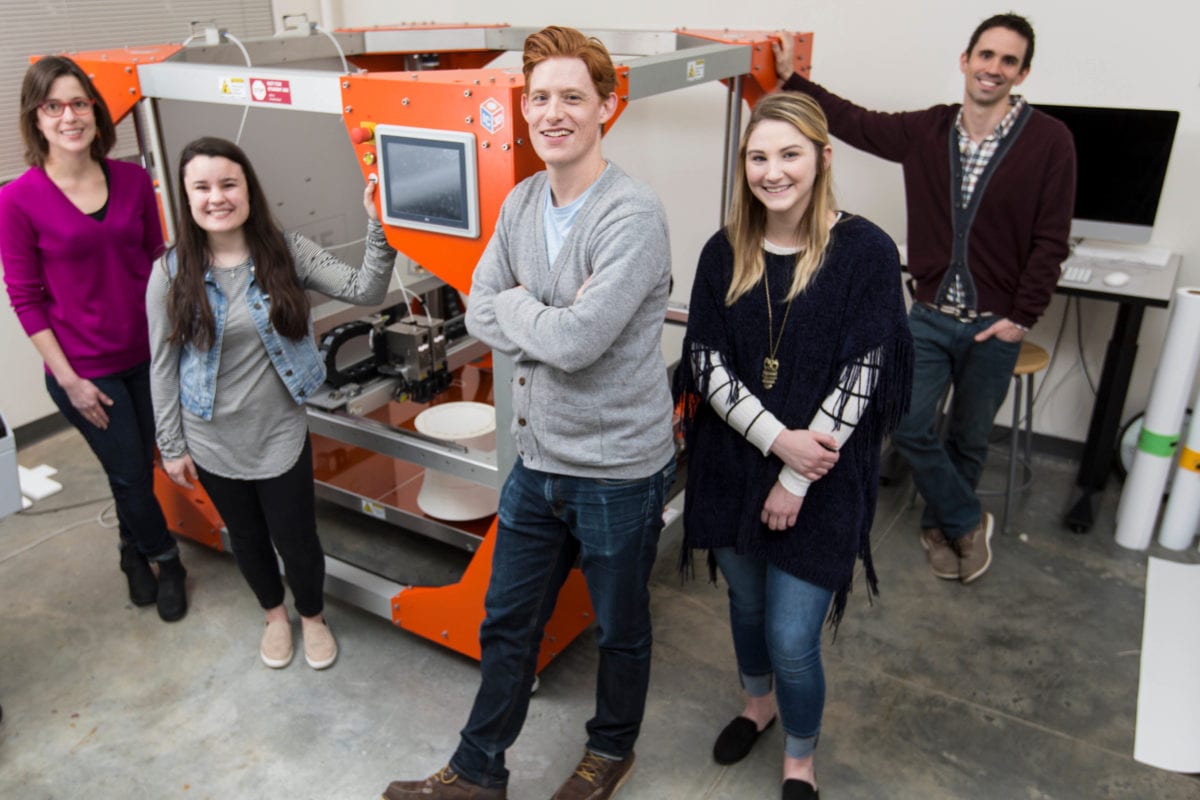The “Godzilla” 3D printer, Big Rep One, whirs softly back and forth as it creates a contemporary chair—life-size. The bright orange and steel German printer represents the newest technology in Maryville’s Design & Visual Art program.
“The amazing thing about this machine is that where once artists created prototypes of their designs by making small models, they can now take an idea and print it to scale,” says Jonathan Fahnestock, MFA, associate professor of graphic and interactive design and director of design and visual art programs.
The Big Rep One printer is a generous gift from Mary E. Walker, Rn, PhD, FAAN, a member of Maryville’s Board of Trustees.
The 3D printer uses thermoplastic polyester derived from renewable biological sources such as corn starch and sugarcane, and layer by layer it creates the chair and other products.
Fahnestock and Brendan McFarland, manager of the new Fabrication Center, or FAB Center, spent last summer reconfiguring studios and learning the ins and outs of the monster of all 3D printers. Moving the painting studio to a larger space allowed the department to move Big Rep One, along with all the other fabrication and replication machinery, into one studio.
Jessica Senne, AIA, NCIDQ, assistant professor of interior design, jumped at the opportunity to incorporate the 3D printer into her classes. Senne won an Outstanding Faculty Award in 2016 for embracing technology as a teaching tool and connecting Maryville with other communities. She did just that with her pre-school chairs project.
“Last year my students identified a concept and worked on a form for an ergonomic chair for pre-school children,” says Senne. “Two of those students came up with a conceptual derivation of an apple core with a slightly rounded bottom, sitting on its end. The benefits of the stool for children are similar to that of a large rubber ball for an adult. It works their core.”
Laura Kreher and Megan Terry, now juniors, twirled the stool around, testing its movement, perfecting their creation. A second printing of the stool is planned and there is even talk of creating a few more for the local pre-school. They agree it needs sand in the bottom to better stabilize it. They talked about the research they conducted to create a small backless stool for wiggly three- and four-year-olds.
“In addition to ergonomics, chairs and materials, we researched preschoolers, their height, energy levels and behavior before we started creating prototypes,” says Kreher. “We also had to learn several new software programs including advanced 3D modeling software known as Rhinoceros, or Rhino.”
Terry considers herself “pretty lucky” to be able to work with the new printer.
“Model making is important in interior design and being able to print something life-size is definitely an advantage in visualizing information,” she says.
Senne, a registered architect and mid-century modern aficionado, offers her students advice worth saving: “You can design anything you can dream. That’s the ubiquity of technology. It allows us to do that.”
“Given the tremendous amount of excitement this machine has created, we anticipate students in other disciplines such as sculpture, ceramics and other arts will be using the printer,” says Fahnestock.
 NEW DIMENSIONS: Students in Design & Visual Art programs bring models to life in a big way with the help of Big Rep One, a state-of-the-art 3D printer. A recent project involved (l to r) Jessica Senne, AIA, NCIDQ, assistant professor of interior design; student Laura Kreher; Jonathan Fahnestock, MFA, associate professor and director of design and visual art programs; student Megan Terry; and Brendan McFarland, manager of the FAB Center.
NEW DIMENSIONS: Students in Design & Visual Art programs bring models to life in a big way with the help of Big Rep One, a state-of-the-art 3D printer. A recent project involved (l to r) Jessica Senne, AIA, NCIDQ, assistant professor of interior design; student Laura Kreher; Jonathan Fahnestock, MFA, associate professor and director of design and visual art programs; student Megan Terry; and Brendan McFarland, manager of the FAB Center.